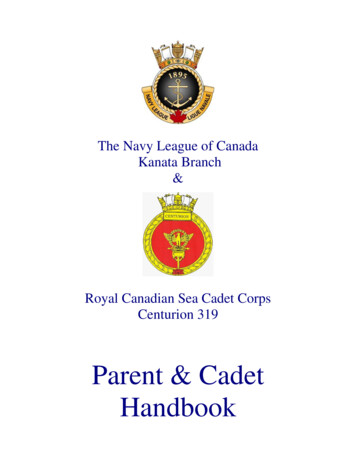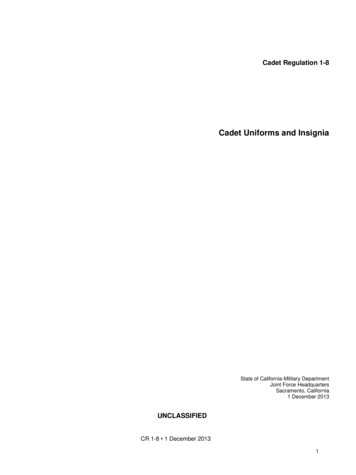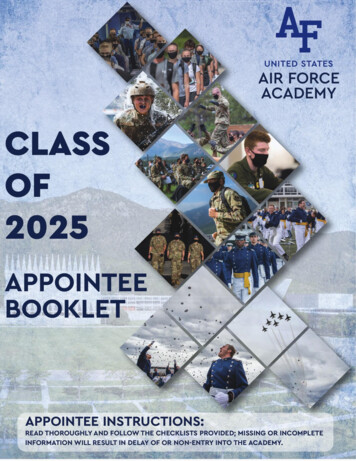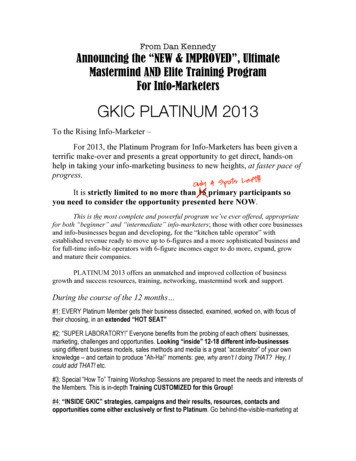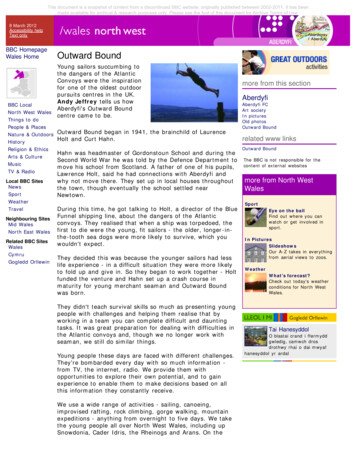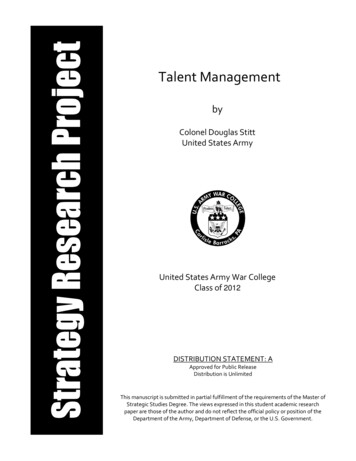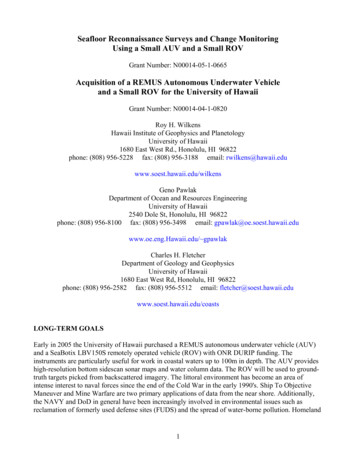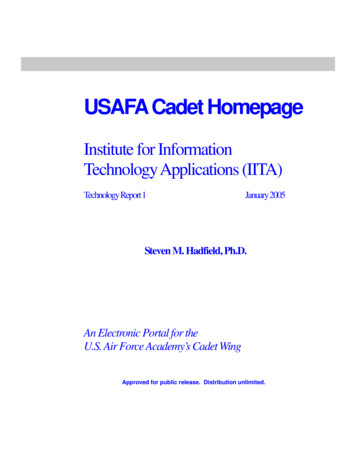
Transcription
USAFA Cadet HomepageInstitute for InformationTechnology Applications (IITA)Technology Report 1January 2005Steven M. Hadfield, Ph.D.An Electronic Portal for theU.S. Air Force Academy’s Cadet WingApproved for public release. Distribution unlimited.
Form ApprovedOMB No. 0704-0188Report Documentation PagePublic reporting burden for the collection of information is estimated to average 1 hour per response, including the time for reviewing instructions, searching existing data sources, gathering andmaintaining the data needed, and completing and reviewing the collection of information. Send comments regarding this burden estimate or any other aspect of this collection of information,including suggestions for reducing this burden, to Washington Headquarters Services, Directorate for Information Operations and Reports, 1215 Jefferson Davis Highway, Suite 1204, ArlingtonVA 22202-4302. Respondents should be aware that notwithstanding any other provision of law, no person shall be subject to a penalty for failing to comply with a collection of information if itdoes not display a currently valid OMB control number.1. REPORT DATE3. DATES COVERED2. REPORT TYPEJAN 200500-00-2005 to 00-00-20054. TITLE AND SUBTITLE5a. CONTRACT NUMBERUSAFA Cadet Homepage: Institute for Information TechnologyApplications (IITA)5b. GRANT NUMBER5c. PROGRAM ELEMENT NUMBER6. AUTHOR(S)5d. PROJECT NUMBER5e. TASK NUMBER5f. WORK UNIT NUMBER7. PERFORMING ORGANIZATION NAME(S) AND ADDRESS(ES)Institute for Information Technology Applications,HQ USAFA/IITA,2354Fairchild Drive, Suite 4L31F,USAF Academy,CO,808409. SPONSORING/MONITORING AGENCY NAME(S) AND ADDRESS(ES)8. PERFORMING ORGANIZATIONREPORT NUMBER10. SPONSOR/MONITOR’S ACRONYM(S)11. SPONSOR/MONITOR’S REPORTNUMBER(S)12. DISTRIBUTION/AVAILABILITY STATEMENTApproved for public release; distribution unlimited13. SUPPLEMENTARY NOTES14. ABSTRACT15. SUBJECT TERMS16. SECURITY CLASSIFICATION OF:a. REPORTb. ABSTRACTc. THIS PAGEunclassifiedunclassifiedunclassified17. LIMITATION OFABSTRACT18. NUMBEROF PAGESSame asReport (SAR)1919a. NAME OFRESPONSIBLE PERSONStandard Form 298 (Rev. 8-98)Prescribed by ANSI Std Z39-18
Table of ContentsIntroductionPurpose and GoalsProject Team OrganizationCapability DevelopedBasic Research AspectsCadet Involvement and feedbackTime Line of Major EventsTransition to OperationsSummary of FundingOther air Force ApplicationsFuture DirectionsConclusionAbout the AuthorAbout IITA23357111214151616161718List of FiguresFigure 1:Figure 2:Figure 3:Figure 4:Figure 5:Screen Shot of the Cadet HomepageFunctional Overview of the Cadet HomepageResults of spring 2003 Cadet Survey (Part I)Results of Spring 2003 Cadet Survey (Part II)Proposed Cadet Homepage O&M OrganizationalStructure561112151The views expressed in this paper are those of the author and do not necessarily reflect the official policy orposition of the Institute for Information Technology Applications, the Department of the Air Force, The Departmentof Defense or the U.S. Government
Cadet Homepage ProjectAn Electronic Portal for the U.S. Air ForceAcademy’s Cadet WingIntroductionThe USAFA Cadet Homepage is the result of an Institute for Information TechnologyApplication (IITA) research effort to develop a single, consolidated access point for cadetinformation. This information includes individual course schedules, status of currentoperations, weather, and links to a full range of electronically available resources.Original research on this capability began in October 1999 under the title Cadet PersonalizedEducational Gateway (CPEG). In August 2002, IITA began implementation of a prototypethat would evolve into fully operational system which would be called the Cadet Homepage.The first prototype was deployed in January 2003 and a full deployment for the Class of 2007occurred in August 2003. The entire Cadet Wing began use of the Cadet Homepage inFebruary 2004 and, by August 2004, the Cadet Homepage had become the primaryinformation resource for the entire Cadet Wing.While this effort was led by IITA, the project team included dozens of individuals from theDean of the Faculty, 34 TRW, 10th Communications Squadron, and Athletics Department.IITA provided management and technical oversight and funding for some required basicresearch as well as initial server hardware. However, the IITA funding was leveraged tosolicit buy in and support from across USAFA mission elements and their investment wasmatched many fold by funding from HQ USAFA, 34TRW, DF, and 10CS to develop the fulloperational capability and provide robust operational server hardware.At present, the Cadet Homepage was become fully integrated into cadet life and Cadet Wingoperations. Operation of the Cadet Homepage is well in the hands of the 10thCommunications Squadron and management is being transitioned from the IITA ProjectOfficer to the USAFA Chief Information Officer’s staff and the 10th CommunicationsSquadron. However, IITA involvement in the project continues primarily in terms ofproviding basic research to enhance functionality and to develop spin-off capabilities like aFaculty/Staff Homepage and a Course Web Site Template.This report documents the progress made to date on the Cadet Homepage project.Specifically, we enumerate the purpose and goals of the project, summarize the project teamorganization, review the capabilities developed, discuss the basic research involved, presentsome cadet feedback and assessment findings, describe the timeline of major events, reviewfunding issues, overview the transition to operations, outline future directions, and suggestsome other Air Force applications of this technology.2The views expressed in this paper are those of the author and do not necessarily reflect the official policy orposition of the Institute for Information Technology Applications, the Department of the Air Force, The Departmentof Defense or the U.S. Government
Purpose and GoalsThe purpose of the Cadet Homepage project has always been to improve cadet timemanagement effectiveness and efficiency via information technology while also enhancingtheir abilities to understand and utilize such technology.In order to accomplish this purpose, the Cadet Homepage Project Team established a numberof goals which served to define the project. These goals were: Provide personalized course schedule information to each cadet with direct linksto their courses’ web-based resources.Provide current status information to include command alerts (Force ProtectionCondition, Homeland Security status, Information Protection condition),command notices, airfield operations status, uniform of the day, Mitchell Hallmenus, weather conditions, and Checkpoints.Provide electronic calendar tools to promote time management skills.Provide a full-range of functionally organized hyperlinks to electronicallyavailable information resources.Provide a comprehensive, content-based search mechanism for locatinginformation on the Cadet Homepage, USAFA web sites, and USAFANETshared drives.Provide a monitored announcements/bulletin board capability for any user topost relevant information.Provide direct access to primary external information resources such as the AirForce Portal.Provide consolidated access to email, organizational calendars, organizationalweb sites, and other key resources.Provide simple, yet robust, tools for authorized users to manage and maintaindynamic content with little or no trainingProvide on-line help resources so users can easily utilize all features of theCadet HomepageProvide an automated feedback mechanism to support the continued refinementof the capabilities.At the current time all of these goals have been accomplished and usage of the CadetHomepage averages between 16,000 and 25,000 unique sessions every day. However,research and development continues to refine the effectiveness and efficiency of thesecapabilities and to more tightly integrate them with other USAFA resources such as the CadetAdministrative Management Information System (CAMIS).Project Team OrganizationThe Cadet Homepage Project Team was a cross-mission element effort from the verybeginning and the project has benefited greatly from the many and varied contributions ofeach mission element and the individuals involved. The list below identifies the keyorganizations and individuals included on the Project Team. However, even this long list isnot exhaustive and there have been many others who have contributed to the effort in avariety of capacities.3The views expressed in this paper are those of the author and do not necessarily reflect the official policy orposition of the Institute for Information Technology Applications, the Department of the Air Force, The Departmentof Defense or the U.S. Government
IITA Gen (ret) McCarthy (Director) Dr Steve Hadfield (Project Manager) Lt Col Jim Harper (Managing Dir) Lt Col Gwen Hall (Project Manager: Aug 02 – Dec 02) Dr Peg Halloran (Project Manager: Oct 99 – Jul 02) Col Rolf Enger Lt Col Tony Aretz Sharon Richardson34 TRW Maj Ovard Maj Philip Winslow Maj Ragsdale Barry Harbor Bill Sheldon Maj John Bernhart Lt Col Cornelius Bill Sheldon Lynn HoppesDF Larry Bryant Carolyn Dull Maj Hal Taylor Doug Johnson Char MossCadet Wing C1C Matthew Russell C1C Todd Tyler C1C Eric Carney C1C Tyson Hoffine (Wingtips) C1C David Brandt C1C Dyan Medina C3C Mike Tanner CS 453/454, CS 364, BS 473 CS 110, CS 220, BS 331, BS 49534TRW/AH Jeff Heidmous Lt Col Ivan Merritt10 CS Arlene Gulley (10CS Project Officer) Neland North Joe McKeehan Fred Layberger Capt Keel Ross Loretta Dotterer & many others Oracle Jim Dalrymple Don Vollmer4The views expressed in this paper are those of the author and do not necessarily reflect the official policy orposition of the Institute for Information Technology Applications, the Department of the Air Force, The Departmentof Defense or the U.S. Government
Capability DevelopedThe Cadet Homepage is a single consolidated and integrated web-based access point for thefull range of cadet information. U.S. Air Force Academy cadets access the Cadet Homepagefrom within the USAFANET local area network via the address: http://homepage/cadet.Figure 1 below illustrates the how the main My Home tab of the Cadet Homepage currentlyappears.Figure 1: Screen Shot of the Cadet Homepage5The views expressed in this paper are those of the author and do not necessarily reflect the official policy orposition of the Institute for Information Technology Applications, the Department of the Air Force, The Departmentof Defense or the U.S. Government
The capabilities and features of the Cadet Homepage currently include the following: Centralized Access PointDynamic Content Managed by Authorized Users via Formso Command Alerts, Notices, Airfield Status, Weather, UOD, Menus, CheckpointsPersonal Calendar with Links to Course Web SitesIntegrated Content-Based Search EngineCAMIS IntegrationFunctionally-Organized Contento Decentralized Content Management and MaintenanceAnnouncementsAir Force Portal IntegrationOn-Line FeedbackFigure 2 below illustrates the breadth of information resources accessible via the CadetHomepage.CadetCommand10ABWPortal Infrastructure *Faculty/Staff*Admin Forms(MyHome, tab navigation structure, shared portlets, DB apps, CAMIS I/F,search mechanisms, I-frames for functional area pages, single sign-on)MilitaryAirfieldAcademicsAthleticsOutlook /ExchangeCAMIS IISupportCadet LifeFunctional Area Web SitesAir ForcePortalCourseWebSites* Not yet implementedFigure 2: Functional Overview of the Cadet HomepageThe current implementation of the Cadet Homepage uses the Oracle 9i Applications Serverproduct suite making primary use of the Portal and UltraSearch applications in that suite. Theoperational production server is a Sun V880 four-processor computer funded by HQ USAFAand acquired and maintained by the 10th Communications Squadron. A test and backupserver is provided by an IITA-owned SunFire 280R two-processor server. Development andmaintenance of the Cadet Homepage software is accomplished on a 10CS-owned SunFire6500 server.6The views expressed in this paper are those of the author and do not necessarily reflect the official policy orposition of the Institute for Information Technology Applications, the Department of the Air Force, The Departmentof Defense or the U.S. Government
Basic Research AspectsSeveral objectives of the Cadet Homepage project could not be readily achieved with thetechnology that existed at the time of its development. Specifically, these objectives involvedthe inclusion of individualized personal calendars with synchronized course appointments thathyperlink to course and lesson web sites as well as securely authenticated users without theuse of a distinct login for the Cadet Homepage. Both of these objectives were critical for theproject and required extensive research and the development of new software as well as theuse of emerging new commercial technology. We had basic research funding from IITA tohelp accomplish these objectives. In this section we document the basic researchaccomplished during this project to satisfy these objectives to include what has beenaccomplished and what remains pending further investigation.Personal Calendar FeaturePerhaps the most important objective of the Cadet Homepage project was the inclusion of apersonal calendar on the main view which is individualized for each cadet and shows theircourse schedule with hyperlinks to course and lesson web sites as well as other obligations.The initial approach was to create this personal calendar as a custom portlet databaseapplication tied to the Cadet Administrative Management Information System (CAMIS)database. CAMIS is the authoritative source for cadet schedules and as such is a logical andefficient host for the personal calendars. However, a CAMIS-based personal calendar wouldrequire some extensive software development and would replicate much of the functionalityexisting in current commercial-off-the-shelf products such as Microsoft Outlook. This wouldresult in extensive costs to develop and maintain this custom capability. A better solutionwould be to decentralize the calendar processing to the client machines. In addition, theCAMIS approach would be server-based and would require an extensive server hardwareinfrastructure to support, whereas Microsoft Outlook is client-based and would decentralizethe calendar processing. Furthermore, the Air Force as well as DoD uses Microsoft Outlookas a common mail client and, in deed, many Air Force and DoD organizations use the richcalendar capabilities of Outlook for complex scheduling tasks. After extensive research of thetwo approaches, the Cadet Homepage research team decided to pursue the use of Outlookpersonal calendars to provide the needed functionality for the Cadet Homepage. The theorywas that this would provide the most cost effective solution and best prepare our cadets foractive duty.Use of Microsoft Outlook CalendarsHowever, in order for the Outlook personal calendar approach to be viable, several significanttechnological challenges had to be overcome. First, we had to be able to view the Outlookpersonal calendars directly from within the Cadet Homepage primary web page. Second, wehad to bring the course appointments in from the authoritative data source (CAMIS database)and keep them synchronized with any changes that occurred after the import. Third, we hadto be able to hyperlink the course appointments to the appropriate course and lesson web sitesin such a way that sites could change but the links would still take the user to the latest site.Finally, we had to make the entire mechanism simple and easy to use. Most cadets were notaccustomed to using an electronic personal calendar and they would only change to do so if itwere very easy to use and provided significant benefit.7The views expressed in this paper are those of the author and do not necessarily reflect the official policy orposition of the Institute for Information Technology Applications, the Department of the Air Force, The Departmentof Defense or the U.S. Government
Embedding Outlook Calendars in Web PagesThe first challenge of integrating the Outlook personal calendars into the Cadet Homepagemain web page was accomplished by locating and adapting an ActiveX control that coulddirectly interface with Outlook. This control was embedded with an HTML portlet in theCadet Homepage using an OBJECT HTML tag. The use of relative paths within theActiveX control parameters allowed us to being up the personal Outlook calendar of theindividual currently logged into the client machine just as we needed for this functionality.The one draw back to this approach is that the ActiveX control relies on the use of theMicrosoft Internet Explorer browser and will not work with most other browsers. However,the Air Force Academy has a site license for the Internet Explorer browser and it was alreadythe de facto standard browser for the Academy.Synchronizing Course Appointments between CAMIS and OutlookThe next challenge was to bring the course and lesson appointment data from CAMIS as theauthoritative data source into the Microsoft Outlook and Exchange infrastructure. This sort ofcross-calendar synchronization is actually a much tougher problem than it would appear onthe surface. Our review of commercial products revealed that no company has fully resolvedthe problem with a currently available product. This includes Microsoft with their Officeproduct (which includes Outlook) and Oracle with their Office Collaboration Suite product.The closest commercial solution that we found was from Infotriever which can synchronizeand update appointments in Outlook based upon data from an authoritative data source.However, the Infotriever solution currently requires the use of their servers outside of thecorporate firewall. Furthermore it is costly (relative to Academy IT budgets) and wouldsignificantly stress limited off-base bandwidth during peak calendar synchronization timeperiods like the beginning of semesters. Hence for reasons of security, cost, and bandwidth,the Infotriever solution was not currently viable.1Another approach that we investigated were use of XML (eXtensible Markup Language) datatransfers between CAMIS and the Microsoft Exchange mail/calendar servers. However, atthe time, the Academy was using Exchange Version 5.5 which did not readily support XMLand migration to the XML-enabled Version 2003 did not occur until August 2004. Hence thisapproach may be viable in the future but was not reasonable during the time this issue wasbeing explored.The approach that was taken was two-fold. The near-term solution was achieved by writing asmall custom application in Visual Basic using COM (Component Object Model) objects tointerface with Outlook. The application was downloaded on to the client computers by theusers using a link on the Cadet Homepage. It could then be run stand-alone by the user ontheir client computer. The interface allowed the user to specify which course they had andduring which period(s). The application would use this information together with a commonM- and T-day shared calendar that they would have copied to their computer to specify all theappointments for that course. The process would be repeated for each course in their scheduleand the entire activity would take under two minutes to complete. Updates to ones schedule1We did investigate alternative configurations such as hosting Infotriever on a local server and thecompany was amenable to this approach but it would require some significant software development ontheir side and some non-trivial training and additional manpower for the Academy.8The views expressed in this paper are those of the author and do not necessarily reflect the official policy orposition of the Institute for Information Technology Applications, the Department o
capabilities and to more tightly integrate them with other USAFA resources such as the Cadet Administrative Management Information System (CAMIS). Project Team Organization The Cadet Homepage Project Team was a cross-mission element effort from the very beginning and the project has be
